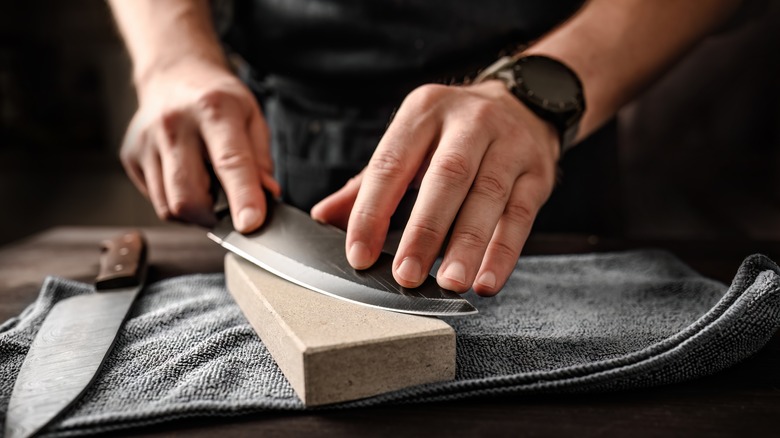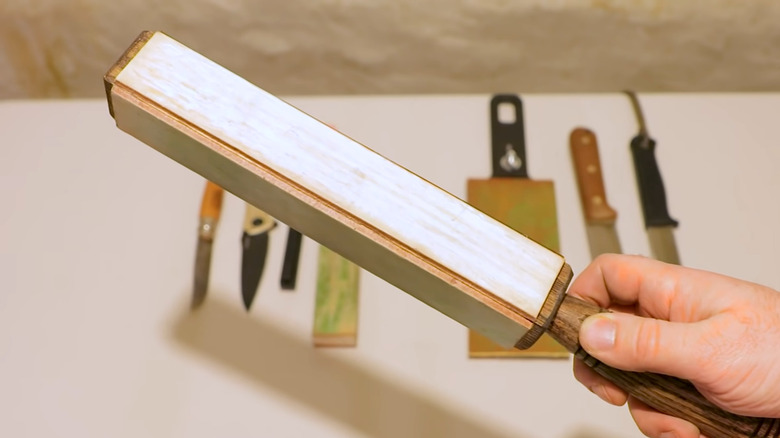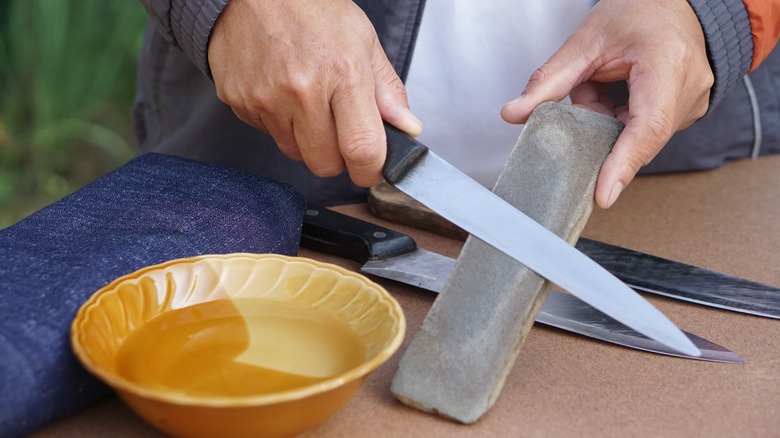Stropping Vs Whetstone: Here's The Best Knife Sharpening Technique
Sharpening knives might seem like a straightforward process, but when you start looking into blade maintenance, you will discover multiple techniques with passionate advocates for each one. Two of the most common methods used to sharpen knives are stropping and using a whetstone. These approaches offer distinct benefits and serve different purposes, making them both valuable tools for maintaining your knives.
Stropping is a technique that involves running the blade across a leather or canvas strip, often treated with an abrasive compound, which fine-tunes the edge of the blade. Stropping is a great option to act as a finishing step after sharpening, giving the blade some extra polish and sharpness. Whetstones are optimal tools for grinding down the metal of the blade to sharpen it. These stones come in different grits, allowing for both coarse sharpening and fine honing.
Both of these methods have their place in knife maintenance, and neither can truly claim the title of "best" sharpening method. Instead, it's about understanding what each technique offers and knowing when to use one versus the other. It's also important to note that there are some scenarios, such as sharpening a serrated knife or removing rust from your knives, where neither method is useful. By learning the pros and cons of both stropping and whetstone sharpening, you can make an informed decision based on your needs, whether you're an everyday home cook or a professional looking to maintain high-performance blades.
Stropping for edge refinement
Stropping is primarily used as a finishing technique rather than as the main sharpening method. It involves dragging the knife across a strip of leather (or sometimes canvas) in the opposite direction of cutting. The strop is often treated with an abrasive compound that polishes the edge and removes tiny burrs left behind by other sharpening methods, which leaves the blade incredibly sharp and shiny. It is often used by barbers when sharpening their razors, or for whittlers and wood carvers. That said, kitchen and outdoor knives also benefit from stropping.
One of the main benefits of stropping is that it's gentle on your blade. Since you're not grinding the knife against a hard surface, there's very little wear and tear on the metal. This helps to extend the lifespan of your knife. Stropping is also quick and convenient, allowing you to maintain a sharp edge without needing a full sharpening session. And since you don't need to carry around a heavy whetstone, it's great for those who need to keep their knives sharp on the go, like hunters or campers.
However, stropping has its limitations. It's not effective for fixing a really dull or damaged blade. Stropping is mainly for refining and maintaining an already sharp edge rather than creating one. If your knife has gone too long without sharpening, stropping alone won't bring it back to life. Additionally, mastering the correct technique and angle takes some practice since improper stropping can actually round off the blade's edge, reducing sharpness instead of improving it.
Whetstone for sharpening and restoration
Whetstones are the tool of choice for more significant sharpening needs. They come in a variety of grit levels, ranging from coarse to fine, and allow you to grind away at the metal to reshape and sharpen your knife. Whether your blade is dull or chipped, a whetstone can bring it back to a sharp, functional state. One of the biggest advantages of a whetstone is its versatility. You can address a wide range of issues, from quickly refreshing a slightly dull edge to completely restoring a damaged blade, making it useful for everything from kitchen knives to sharpening multi-tool pocket knives. Whetstones give you control over the sharpening process, allowing you to choose the level of refinement based on the condition of the knife.
On the downside, using a whetstone requires time and skill. It's a more involved process than stropping, and getting the right angle and pressure takes practice. Additionally, sharpening on a whetstone can remove more metal from the blade, which means your knife will wear down faster if used too often or improperly. Whetstones also require regular maintenance, such as flattening the surface to ensure it sharpens evenly over time. Neither stropping nor whetstone sharpening is inherently better than the other. Instead, they serve different purposes in knife maintenance. Understanding when to use each method allows you to maintain your knives in the best possible way.


